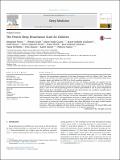The French Sleep Disturbance Scale for Children

Auteur, co-auteurs
Type de référence
Date
2016-12-21Langue de la référence
AnglaisEntité(s) de recherche
Clinical Health Psychology, University of Ulster, Coleraine, Londonderry, United Kingdom
Institute of Pharmaceutic and Biological Sciences, University Claude Bernard Lyon 1, Villeurbanne, France
Emerging Pathogens Laboratory e Fondation M erieux, International Center for Infectiology Research (CIRI), Inserm U1111, CNRS UMR5308, ENS de Lyon, University Claude Bernard Lyon 1, Lyon, France
GKC-Rett Expertise Center e MHeNS, Maastricht University, The Netherlands
Epilepsy, Sleep and Pediatric Neurophysiology Department, University Hospitals of Lyon (HCL), Lyon, France
Department of Developmental and Behavioral Pediatrics, Shanghai Children's Medical Centre Affiliated with Shanghai Jiaotong University School of Medicine, China
INSERM-U1028, CNRS UMR5292, University Claude Bernard Lyon 1, Lyon, France
Résumé
Objective: The psychometric properties of the Sleep Disturbance Scale for Children (SDSC) have been shown to be accurate, even when translated into several languages. The aim of the present study was to translate, adapt, and validate the SDSC for a French-speaking population. Methods: After forward- and back-translation, the tool was further translated and adapted into the French language. It was then pretested in terms of clarity on 33 French-speaking parents. Pretesting demonstrated that the questionnaire was well understood, indicating good clarity. During the validation phase, a total of 447 French-speaking parents of children aged between 4 and 16 years completed the SDSC. Among these, 66 children were diagnosed with sleep disorders by a pediatric specialist after a sleep consultation and polysomnographic recordings. Results: The factor analysis revealed five factors: difficulty in initiating and maintaining sleep (DIMS), sleep breathing disorders (SBD), disorders of excessive somnolence (DOES), parasomnias (PARA) and non-restorative sleep (NRS). This psychometric structure is reliable and logical in comparison with the experts' diagnoses. Convergent validity, divergent and internal reliability are very good. Inter-parental concordance in scoring the child's sleep problem does show differences in the ways in which parents report their children's sleep patterns. Cut-off was calculated for the total score (45). Conclusion: This study validated a 25-item French version of the questionnaire. The French SDSC could therefore be used to aid screening of sleep disorders in the general population.Titre du périodique
Sleep MedicineMaison d’édition
ElsevierVolume / tome
32Pagination
56-65Public(s) cible(s)
Chercheursprofessionels du domaine
URL permanente ORFEE
http://hdl.handle.net/20.500.12162/6495Autre(s) URL(s) permanente(s)
http://doi.org/http://dx.doi.org/10.1016/j.sleep.2016.12.008Document(s) associé(s) à la référence
Texte intégral :
Fichier
Accès
Commentaire
Version
Taille
- Tout ORFEE
- Détail référence



